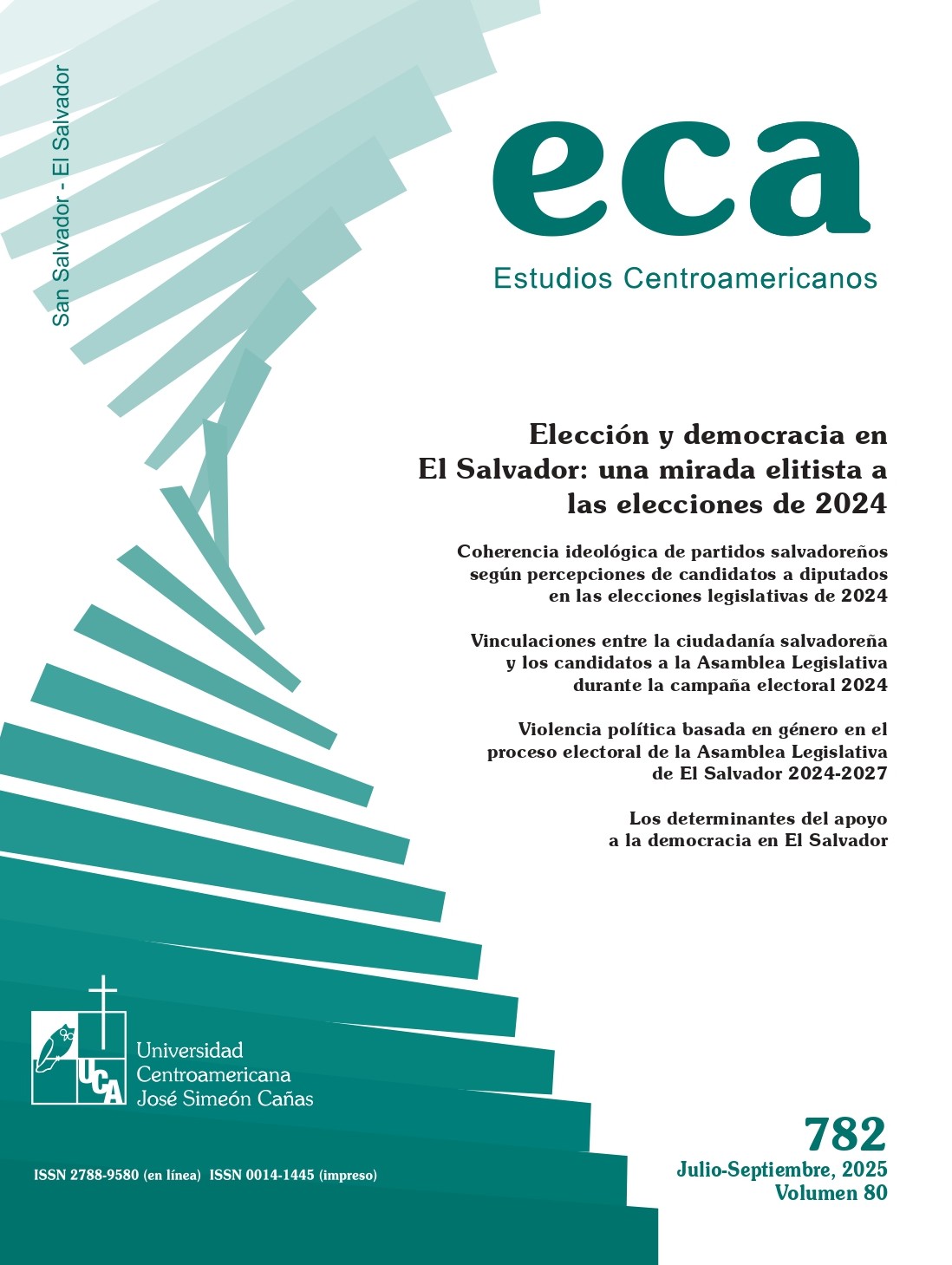Abstract
This research article examines the levels of ideological coherence of political parties based on the perceptions of candidates for deputies who participated in El Salvador's Legislative Elections in 2024. A total of 62 polls were carried out among candidates for deputies of the Nationalist Republican Alliance (ARENA) with 12 cases, the Farabundo Martí National Liberation Front (FMLN) with 10 cases, the Grand Alliance for National Unity (GANA) with 2 cases, Nuevas Ideas with 11 cases, Nuestro Tiempo with 11 cases, the Christian Democratic Party (PDC) with 4 cases and VAMOS with 12 cases. This paper analyses the results of the level of coherence of the candidate´s ideological self-location and their perception of their parties´ ideological location in the left-right continuum. The results show that younger parties, such as Nuevas Ideas, Nuestro Tiempo, and VAMOS, tend to be located in the center of the ideological spectrum with a high level of ideological coherence, while traditional parties such as ARENA and FMLN are at opposite extremes, the former with a high level of ideological coherence and the latter with a lower level of ideological coherence. In addition, it is observed that Nuevas Ideas shows a high level of ideological coherence, similar to that of ARENA and Nuestro Tiempo, which could be indicative of a more predictable and effective legislative behavior. Finally, the research concludes that high ideological coherence facilitates accountability and ensures stable levels of electoral support, while low coherence poses challenges for parties to maintain electoral support.
References
Alcántara Sáez, M. (2004). ¿Instituciones o máquinas ideológicas? Origen, programa y organización de los partidos latinoamericanos. Institut de Ciències Polítiques i Socials.
Alcántara Sáez, M. y Luna, J. P. (2004). Ideología y competencia partidaria en dos post-transiciones: Chile y Uruguay en perspectiva comparada. Revista de Ciencia Política, 24(1), 128-168. https://www.scielo.cl/scielo.php?script=sci_arttext&pid=S0718-090X2004000100006
Carey, J. (2009). Legislative Voting and Accountability. Cambridge University.
Heller, W. y Mershon, C. (25- 28 de abril de 2002). Dealing Discipline: Party Switching and Legislative Voting in the Italian Chamber of Deputies, 1996-2000 [Sesión de conferencia]. Annual Meetings of the Midwest Political Science Association, Chicago, Estados Unidos.
Ideological Competition. (2019, 9 de enero). Coherencia partidista: concepto y operacionalización [Video]. YouTube. https://www.youtube.com/watch?v=GNu0SptxX_k
Janda, K. (1993). Comparative Political Parties: Research and Theory. En A. W. Finifter (Ed.), Political Science: The State of the Discipline II (pp. 163-191). American Political Science Association.
Jones, M. (2002). Explaining the High Level of Party Discipline in the Argentine Congress. En S. Morgenstern y B. Nacif (Eds.), Legislative Politics in Latin America (pp. 147–184). Cambridge University Press.
Kitschelt, H., Mansfeldová, Z., Markowski, R. y Toka, G. (1999). Post-communist Party Systems, Competition, Representation, and Inter-party Collaboration. Cambridge University Press.
Marroquín, W. E. (2020, 30 de septiembre). Ideología y teoría espacial de la competición en la determinación del sistema de partidos en El Salvador. ECA: Estudios Centroamericanos, 75(762), 63-90. https://doi.org/10.51378/eca.v75i762.3277
Michels, R. (1991). Los partidos políticos. Un estudio sociológico de las tendencias oligárquicas de la democracia moderna. Amorrortu editores.
Morales Quiroga, M. (2014, 1 de enero). Congruencia programática entre partidos y votantes en Chile. Revista Perfiles Latinoamericanos, 22(44), 59-90. https://doi.org/10.18504/pl2244-059-2014
Otero, P. (2011). Congruencia ideológica e integración europea: un análisis de los vínculos entre los votantes y partidos en Europa [tesis de doctorado, Universidad de Salamanca].
Özbudun, E. (1970). Party Cohesion in Western Democracies: A Causal Analysis. Beverly Hills.
Real Academia Española. (2014). Diccionario de la lengua española.
Ruiz Rodríguez, L. M. (2006). Coherencia partidista: La estructuración interna de los partidos políticos en América Latina. Revista Española de Ciencia Política, (14), 87-114. https://recyt.fecyt.es/index.php/recp/article/view/37422
Ruiz Rodríguez, L. M. (2007). La coherencia partidista en América Latina. Parlamentarios y partidos. Centro de Estudios Políticos y Constitucionales.
Ruiz Rodríguez, L. M. y García Montero, M. (2003). Coherencia Partidista en las Elites Parlamentarias Latinoamericanas. Revista Española de Ciencia Política, (8), 71-102. https://recyt.fecyt.es/index.php/recp/article/view/37341
Ruiz Rodríguez, L. M. y Otero Felipe, P. (2013). Indicadores de partidos y sistemas de partidos (vol. 51). Centro de Investigaciones Sociológicas.
Sani, G. y Sartori, G. (1980). Polarización, fragmentación y competición en las democracias occidentales. Revista del Departamento de Derecho Político, (7), 7-37. https://pdfs.semanticscholar.org/840d/df5c2ada422f09feaeff6118d91cf4fbf8ca.pdf
Sartori, G. (2005). Partidos y sistemas de partidos. Marco para un análisis (2.a ed.). Alianza Editorial.
Universidad de Salamanca. (2021). Proyecto Élites Latinoamericanos (PELA-USAL) [conjunto de datos]. PELA. https://oir.org.es/pela/access-database/

This work is licensed under a Creative Commons Attribution-NonCommercial-NoDerivatives 4.0 International License.
Copyright (c) 2025 Johan S. Larreynaga






